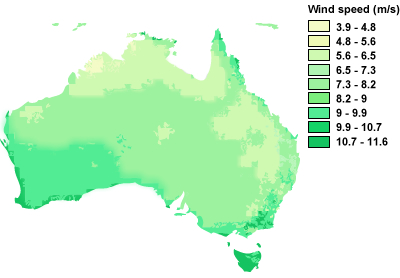
Wind, like solar, can help you generate your own electricity using an infinite and fuel-free resource – and sometimes it may make more sense than solar. Find out if wind power is right for you.

Wind, like solar, can help you generate your own electricity using an infinite and fuel-free resource. Modern wind turbines are capable of returning up to 50% of the wind energy collected as electricity, which can be stored in a battery bank and/or fed back into the grid. The decision to choose wind power instead of (or in accompaniment to) a solar power system will come down to a few things – in particular where your home’s situated, how much sunlight and breeze you get throughout the year, and whether or not you’re able to put up the necessary hardware in either case.
Where wind is best
Australia has some of the best wind resources across the world, with large, open spaces available at key locations where strong and consistent winds blow all year round. The strongest winds are found around the Bass Strait, across southern Victoria and Tasmania. Wind power generation in these areas can provide a very solid alternative to solar power, particularly because the sun’s light isn’t as strong as it is in most other parts of Australia.
How does wind power differ from solar?
There are many practical points on which solar and wind energy are very similar, but each has its own advantages and disadvantages. Wind’s key advantage over solar power is that it’s not restricted by available light, and will keep operating throughout the night. This means that you can keep your power flowing almost all the time, rather than generating energy for only half the day (or less, as is the case in the depths of winter).
Turbines do rely on moving parts though, so will require more maintenance and upkeep than solar panels will. They can also produce some noise too. How much noise a trubine produces will depend on how big it is, though most turbines are high enough that this is limited to a dull hum even at its most noticeable.
Renewable energy source
The primary advantage of choosing wind power is the same as that for solar – producing electricity from an infinite resource that requires no fuel to sustain. Every kilowatt produced by a renewable energy source is one kilowatt less that needs to be generated by a coal power station, reducing greenhouse gas emissions and power supply costs. In essence, once the system is bought and installed, it will start generating power and savings, and reduce coal usage and environmentally harmful emissions.
Common uses
Wind power generation has become the focus of many large scale operations around Australia which has caused contention in some communities, but has so far been quite successful in generating useful amounts of power to feed into the grid.
Wind power for domestic applications is most common on large rural properties where getting connected to the grid is a pain. Wind’s often used to power water pumps to supply water for livestock and crops too.





